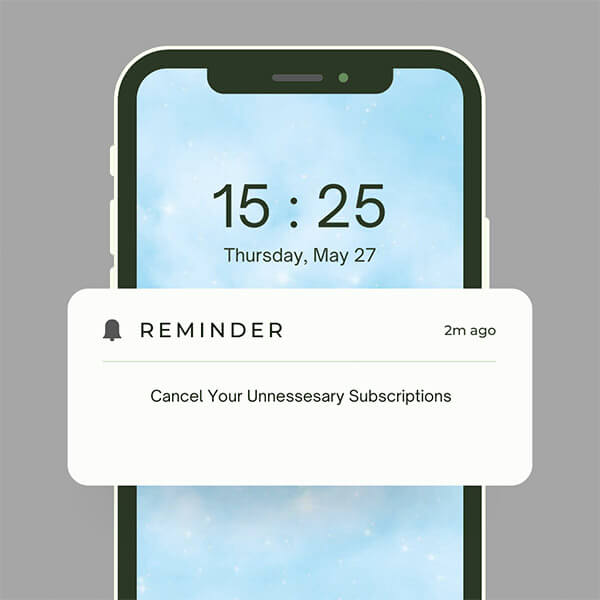The world has gone subscription crazy. You can sign up for almost every service known to man, and probably a few that haven’t been invented yet.
It’s fast, convenient and oh-so-easy. So easy that subscription services can imperceptibly drain hundreds and even thousands out of your bank account.
Millions of consumers have been lulled into forgetting they even have subscriptions. Instead of a one-time fee, services want you to pay month after month after month. Money slowly and quietly seeps away.
That would be a problem in normal economic times. With inflation running about 10%, it’s turning into a drain few can afford to ignore.
There is a simple way to patch the leakage. Apps have come along that identify and track your subscriptions. When you see you have 17 of them (which the average Millennial does), you might be shocked into cancelling a service or three.
Certain apps will even do that for you. But beware, some require a monthly fee.
Yep, you’re buying a subscription service to get rid of subscription services. It sounds counterintuitive, but don’t laugh it off just yet.
How Subscription Services Can Add Up
In a survey by C+R Research, consumers were asked to guess how much they spend a month on subscriptions. The average was $86.
When they were asked about subscriptions in specific categories, the actual amount was $219. That’s $133 in undetected leakage a month. That’s almost $1,600 a year, not counting the credit card interest charges.
Almost 90% of subscriptions are automatically deducted, according to the survey. Almost 45% of respondents said they were still being charged for subscriptions they never use.
Americans love to be entertained. According to Statista, the average number of paid subscriptions for just media offerings in 2020 was 12. For Millennials, it was 17. That was a lot of Netflix, Fortnite, Paramount-Plus, AdultNode and Roku.
Unless you’re a shut-in with insomnia, there aren’t enough hours in the day to get your money’s worth. What’s worse, it can be a hassle getting out of the contract even if you do realize you’re being taken for a subscription ride.
Some services intentionally confuse users who are looking to quit. The apps have convoluted cancellation procedures and offer more “free trials” that convert into paid subscriptions after a few days.
What’s a consumer to do?
Subscription Solution No. 1
If you think it’s silly to get a subscription service to get rid of subscription services, you can do it yourself. That’s feasible if you’re detail-oriented and financially disciplined.
If you’re motivated to escape, take these steps:
Check your bank and credit-card transactions every day. It will take a few weeks for recurring charges to cycle through. Red flag each one and decide if it fits into your budget or you haven’t used it since the Obama Administration.
Contact the ones you want to drop. The process should be simple, but you should be ready for a runaround or two or 12. Continue daily monitoring of your transactions for at least a month, to make sure you’re no longer being dinged for subscriptions you don’t want.
Subscription Solution No. 2
Have somebody fight the battle for you. Apps scour your spending activity and identify recurring charges. Some will negotiate to have your fees reduced or cancel the subscription.
There are plenty of good money apps out there. Here are a few to consider:
- Truebill – It links into your bank or credit card accounts and sets up a dashboard that lets you monitor transactions, set up a budget, add alerts and cancel subscriptions. Cost is $3 to $12 a month, based on whether you want features like live chat, synching your balances and Cancellation Concierge. For successful bill negotiation, Truebill keeps 40% of the savings.
- Trim – Identifies recurring charges and sets up a dashboard for monitoring. It’s not a mobile app and must be accessed via web browsers. There’s a free version and premium that cost $99 a year. For successful bill negotiation, Trim keeps 15% of the annual amount saved.
- Mint – A free app that reviews credit card and bank account spending across a number of categories. To get the cancellation service, you have to upgrade to Mink Premium for $4.99 a month.
- Subby – A free Android app that requires you to manually enter recurring subscriptions. It then tracks the payments and notifies you of impending charges. A $2.99-per-month version removes ads and automatically backs up data to Google Drive.
Are Subscription Monitoring Apps Worth It?
Life goes by fast. People have been saying that for centuries, but your great-grandparents couldn’t sign up for DashPass and eat Carrabba’s while playing Mortal Kombat via their Xbox Game Pass.
With the digital revolution, it’s easier than ever to forget where your money’s going. Subscription services can be great, but they bank on customer forgetfulness.
The subscription economy generated $650 billion in 2021. UBS Financial Services estimates that’ll boom to $1.5 trillion by 2025. It’s safe to say a chunk of that will be for services people never used.
If you don’t want to contribute to the Forgetfulness Fund, you have to keep track of all your financial transactions and be on a constant lookout for questionable charges. Such diligence is not a problem for some people.
If you’re not one of them, consider subscribing to a subscription service that eliminates subscription services. As screwy as that sounds, it might be the subscription you ever make.
The Subscription Trap
The pandemic turbocharged the subscription industry. Consumers ordered in food and gorged on streaming services.
What’s not to love? Subscribe, and all the necessities of life can appear at your doorstep. The money is charged to your credit or debit cards, and it gets lost amid all the other bills on a monthly statement.
HBO – $9.99. Never mind that you haven’t watched a show since “Game of Thrones” went off.
Home security monitoring – $17.99. Never mind that you moved into a building with a doorman posted 24 hours a day.
Shave Club – $6.00. Never mind that you haven’t used a razor since getting that $199 Norelco shaver for Christmas.
Meat delivery plan – $11. Never mind that you’ve become a vegan.
MasterClass – $15.00. Never mind you don’t have time to master DJing.
Services charge a flat fee whether you order anything or not. So many times, you are essentially paying for nothing.

5 MINUTE READ
Home » InCharge Blog »
Sources:
- O’Brien, S. (2022, June 2) Consumers spend an average $133 more each month on subscriptions than they realize, study shows. Retrieved from https://www.cnbc.com/2022/06/02/consumers-spend-133-more-monthly-on-subscriptions-than-they-realize.html
- NA. (ND) Subscription Service Statistics and Cost 2022. Retrieved from https://www.crresearch.com/blog/subscription-service-statistics-and-costs
- Van Dam, A., Long, H. (2021, June 1) Everything’s becoming a subscription, and the pandemic is partly to blame. Retrieved from https://www.washingtonpost.com/business/2021/06/01/subscription-boom-pandemic/

















